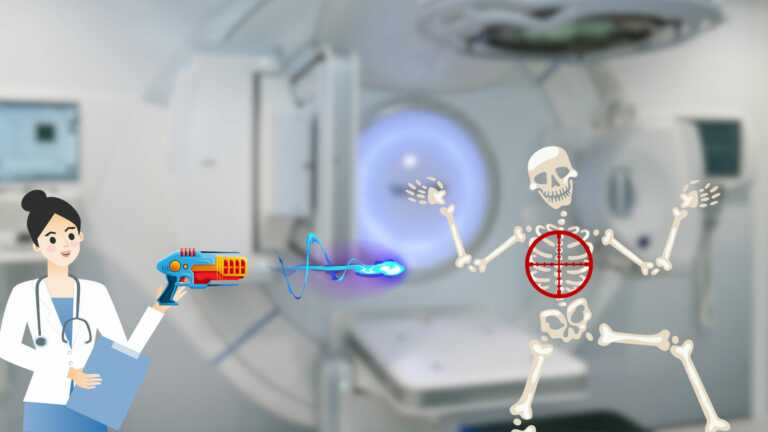The sound of the intercom broke the silence in an exam-room-turned-storage-closet at Sunnybrook’s Odette Cancer Centre.
“Attention, please. Code brown. Flood. Clinic B. 105,” the message repeating.
Yikes. A code brown is an incident involving hazardous bodily fluids. Usually poop. I bet it was poop.
I looked up at the pipes above the exam room, STORM DRAIN stenciled on, and crossed my fingers that I would not fall victim to raining feces.
It was my lucky day.
After some waiting, a team of six people stepped into the room for my consultation—a third opinion on my inoperable liver metastases—and we walked through a plan.
This new team comprises a medical oncologist, hepatobiliary (liver/gallbladder surgeon), a pair of nurses, and a pair of medical residents. This is in addition to my team here in Kingston and the transplant team at Toronto General Hospital and the unnamed radiologists who are so critical to this whole process.
To say that my case is being followed would be an understatement.
There are at least a dozen experts in my corner, helping to move things forward.
Who doesn’t want to help cure a 35-year-old of otherwise terminal colon cancer?
Choosing a path forward
The team I met with oversees the implantation of Hepatic Arterial Infusion (HAI) pumps.
I am a candidate and, after much consideration, I’ve decided to move forward with this procedure.
These hockey puck sized containers deliver a blast of chemotherapy directly to the liver, sparing the rest of the body from side effects and allowing for an extremely large dose of medication to be administered. Since it’s localized, it doesn’t damage cells outside of the liver.
This presents the best option to tackle the enemy I know, being the liver metastases, while keeping the door to a liver transplant open.
My rationale is that the transplant may never happen, either due to eligibility issues or timelines, and the HAI pump will—at the very least—buy me more time without severely impacting my quality of life.
For cancer to spread beyond my liver would disqualify me from both the pump and the transplant, so I believe this to be the most pragmatic approach.
Am I thrilled? No.
Do I think it’s the right choice? Absolutely.
Although both the HAI team and I would skip the pump and go straight to transplant if we could, the bar for transplant is high and the timeline vague.
The HAI team is advocating to expedite the transplant, though there are likely rigid rules in place due to the nature of it being a clinical trial which would prevent any rulebending.
If that changes, the plan may change. For now, this is what I’m rolling with.
What’s next?
I’ll have a ton of scans over the coming month to prepare for surgery in September. These will be to plan the operation and to ensure that I am, in fact, currently stable.
I’ll have to stop my current treatment for about a month to prepare for surgery. This’ll help my body heal after surgery and ensure that I’m clotting the way that I’m supposed to during the procedure.
Surgery itself is a three-hour process. The pump is inserted on my left side and a catheter is passed into the main artery within the liver. My gallbladder will be removed as well. It’ll be a three-ish day stay in the hospital, with a 4-6 week recovery at home.
Before I head home following surgery, we’ll do a test of the pump using radioactive dye to ensure that there are no leaks. This contrast will be viewed through some nuclear imaging to ensure that we’re not leaking chemotherapy into other parts of my body.
Once we confirm that all is well, I’ll move onto receiving FUDR (Floxuridine) chemotherapy through the pump. This will be in addition to the bi-weekly treatment I’m receiving intravenously (except that I likely won’t have to wear a bottle of chemotherapy home for 46 hours).
Chemotherapy through the pump is conducted in two-week cycles. One cycle, I’ll receive medicine. The next, I’ll receive saline and heparin to keep the catheter from clotting. Rinse and repeat.
This will mark time as we work toward the end goal of transplant.
What’s the benefit?
By delivering chemotherapy directly to the liver, we can spare the rest of my body from the side effects of the concentrated medication.
This means that I can have more effective treatment without adding to the already irritating list of physical side effects that I currently experience.
The addition of the HAI pump will really complement the systemic treatment and will work to shrink and keep my liver lesions stable.
It could open the door for surgical resection or ablation of the liver lesions, while also keeping me on the path toward liver transplant.
Some studies indicate a 10-30% response rate for the chemotherapy I’m already on compared to an 80% response rate with the addition of the pump. Although Canadian data is unavailable, this is a far more common procedure in the US, which leaves me feeling optimistic.
The median overall survival for the HAI combined with systemic treatment is also promising: 67 months compared to 44.
I think it’s worth a shot.
What are the risks and drawbacks?
Surgery to implant the pump is not risk-free.
About 20% of patients experience some form of complication. This can range from infection of the wound site, bile issues that require medical drains to be implanted, and problems that require blood transfusion while under general anesthesia.
In some cases, the pump can’t be used at all and needs to be removed or replaced.
Clotting could be an issue as well, though I haven’t had any issues with that through my chest port, so I’m optimistic it’ll be a non-issue for me. Fingers crossed!
It’s also not a guarantee that the FUDR chemotherapy will be effective, though it’s more likely than not that I’ll benefit from it (stupid fucking KRAS mutation). Leakage outside of the intended area is possible.
Down the line, if I do meet transplant eligibility, it will make that surgery more complicated, too. Receiving a liver transplant is also the only reason that the pump would ever be removed, so it’s going to be with me forever.
The final drawback is that I’ll have to make the trek from Kingston to Toronto every two weeks in order to have the pump filled an maintained. It’s a 500 kilometre (~311 mile) roundtrip.
Aside: On the equity of access front, I do plan to see if there’s a way to expand the training for the HAI pump treatment to the Ottawa and Kingston cancer centres. I’ll start working on this over the coming weeks. Sure, surgery will still need to be done in Toronto, but let’s see about sparing some of my capital region friends a 750km roundtrip for lifesaving treatment (at least some of the time).
The best of a bad situation
There aren’t that many choices for a person in my position. The choices that do exist are intrusive, uncomfortable, and irreversible.
Sure, I’m grateful to have options. I fully acknowledge that many people with metastatic cancer simply don’t have any choice in the matter: there’s nothing to be done. That fucking sucks.
My gratitude is contrasted by grief. Moving forward with an HAI pump marks a permanent change to my body and treatment plan.
I’ll have another implanted medical device to care for and worry about. New medication. New risks. New routines.
Travel will be complicated, both for leisure and for treatment, because it is a non-negotiable that the pump is serviced every two weeks. Unlike systemic treatment, I can’t coordinate to simply skip a week here and there.
It also means that I have some soul searching to do in terms of what the future looks like for me.
It’s a major change with equally major ramifications. Time will tell how things play out.








